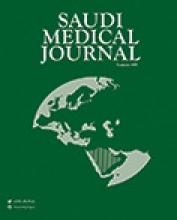Abstract
OBJECTIVE: Naxos disease is a rare hereditary disorder characterized by palmoplantar keratoderma, woolly hair and cardiomyopathy. This study aims to determine whether Naxos disease in a Saudi Arab family is caused by the Pk2157del2 mutation that was identified in Greek families from Naxos Island where the disease had originally been described.
METHODS: This study was undertaken at King Fahad Hospital of the University, Al-Khobar, and the Medical University of Hannover, in the spring of 2003. Naxos disease has been encountered in a 2-year-old girl and her 30-year-old aunt of a Saudi Arab family. Deoxyribonucleic acid samples of this family were analyzed by polymerase chain-reaction (PCR) amplification of the respective region of the plakoglobin gene, and direct nucleotide sequencing of the PCR-products. Segregation analysis was performed employing the newly detected IVS11+22G/A polymorphism.
RESULTS: Molecular genetic analysis of the DNA sample of the child diagnosed with Naxos disease showed absence of the Pk2157del2 mutation. In addition, the segregation analysis revealed heterozygosity for IVS11+22G/A in the affected girl.
CONCLUSION: Absence of the Pk2157del2 frameshift in the affected child proved that Naxos disease in this Saudi Arab family is not caused by the same mutation that was identified in the Greek families. Furthermore, heterozygosity for the IVS11+22G/A polymorphism provided evidence for exclusion of the plakoglobin gene in this consanguineous family.
- Copyright: © Saudi Medical Journal
This is an open-access article distributed under the terms of the Creative Commons Attribution-Noncommercial-Share Alike 3.0 Unported, which permits unrestricted use, distribution, and reproduction in any medium, provided the original work is properly cited.






